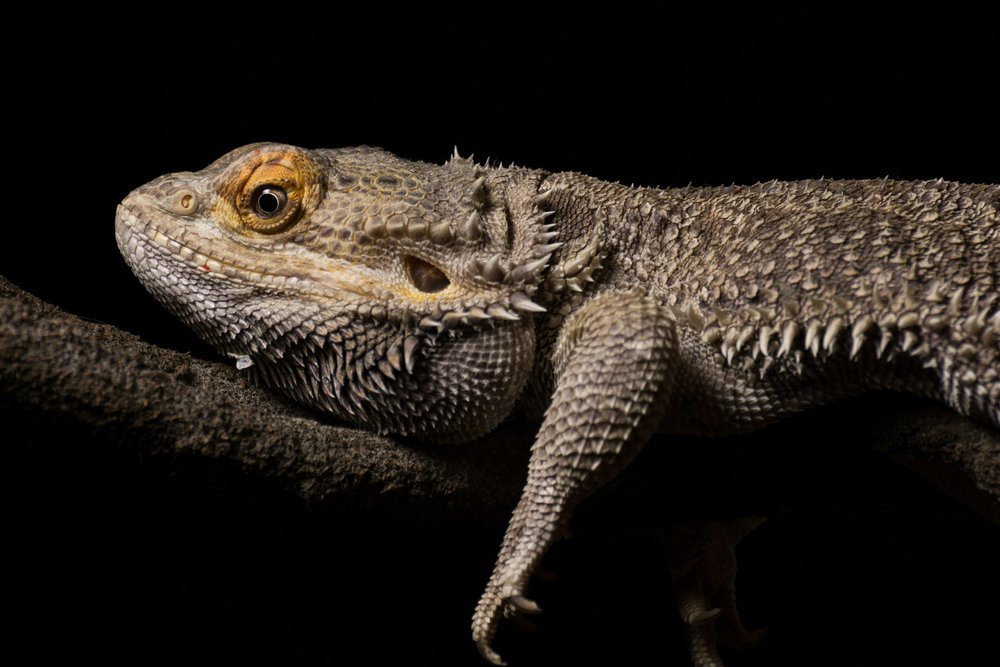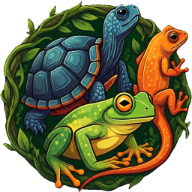
Pogona vitticeps
Introduction
The bearded dragon (Pogona vitticeps) originates from central and southeastern Australia. Their colors can range from light brown to yellow/red. This lizard gets its name from the "beard" it can puff up. Bearded dragons shed their skin in pieces. They are reptiles that can grow to 40 to 50 cm in length and can live approximately 10 to 15 years. Bearded dragons grow quickly and can reach maturity in one and a half to two years. They are diurnal, meaning they are active during the day. Naturally, they inhabit savannas and deserts. They primarily live on the ground but are also good climbers. In the wild, male bearded dragons climb on rocks, fallen branches, and fence posts to oversee their territory. Young bearded dragons often climb trees to escape ground predators. Their habitat is characterized by the absence of water. Bearded dragons mainly drink dew droplets that collect on leaves and their own bodies in the morning. The tail of the bearded dragon is vulnerable and can break; while this does not happen easily, it is still possible. Unfortunately, if the tail breaks, it will not regrow.
Enclosure
The bearded dragon is a solitary animal. It is best to keep them alone, as they can be territorial towards others. Females can also be territorial with one another. Housing bearded dragons together can lead to a lot of stress. They may fight, which could potentially result in death.
They require a water dish where they can partially bathe, so ensure they have fresh water every day. Their habitat should not be too humid, as their skin type does not tolerate it well. The terrarium should be set up before acquiring the bearded dragon. Leave the animal alone immediately after purchase; moving is very stressful for them, so allow them to acclimate to their new environment first.
The terrarium for a bearded dragon should be at least 120x50x50 cm. The substrate should be 15 to 20 cm deep to allow for burrowing. The best substrate is sand. They will also climb if given the opportunity. Therefore, ensure there is height variation within the terrarium using pieces of wood, for example. There should be several flat rocks inside, particularly under the heat lamp. Make sure the bearded dragon never has direct access to the heat source, as they can burn themselves. Additionally, a shallow water dish must be included.
Temperature & lighting
The temperature in the terrarium should be around 25-30 degrees Celsius in the cooler area and 40-45 degrees Celsius under the lamp. Humidity should remain below 50%. Bearded dragons cool themselves by keeping their mouths open. It is advisable to provide the terrarium with a background, as this helps reduce stress. They also require a day-night cycle of about 10-12 hours of light per day, which can be achieved by adding a timer. A lock is useful to prevent children from accessing the terrarium. To synthesize vitamin D3, they need UV light, as reptiles produce vitamin D3 in their bodies through exposure to UV light. Vitamin D3 is necessary for calcium absorption. A UV lamp should be replaced once a year. It is best to choose T5 or T8 lighting.
Food & supplements
Certain types of vegetables (red cabbage, Brussels sprouts, pointed cabbage) can cause problems with the thyroid when consumed excessively and may lead to digestive issues in reptiles. Vegetables that contain oxalic acid (such as carrots, broccoli, parsley, and spinach) can draw calcium from the body. However, these vegetables also contain other substances that can be beneficial for bearded dragons. Fruits such as apple, pear, tomato, grape, various types of berries (gooseberry, blueberries), strawberries, cactus fruit, mango, tangerine, banana, and papaya are also favorites among these animals. Fruit is very high in sugars and should be offered in moderation. Bearded dragons rely on microorganisms in their intestines for the digestion of their food. An excess of sugar can disturb the gut flora and result in diarrhea. Wild plants like plantain, dandelion, dandelion leaves, clover, violets, white dead-nettle, and nettle can be fed to bearded dragons. Some specialty pet stores offer specially edible live plants for herbivorous reptiles.
The following vegetables could be used
- Endive
- Bok choy
- Chicory
- Radicchio
- Beet leaf
- Watercress
- Beet (small quantities)
- Sweet potato (small quantities)
- Cauliflower
- Spinach (small quantities)
- Bean sprouts
- Bell pepper
Care & Handling
Reptiles are primarily display animals and not pets for cuddling. You cannot allow a bearded dragon to roam freely indoors. Drafts and temperature fluctuations can make them very ill. Do not simply take the animals out of their enclosure. If you do need to handle your reptile, for example for a health check, it is advisable to wash your hands before and after handling. It is important to keep the terrarium clean. The substrate, glass, and decorations should be free from droppings, and any uneaten food items should be removed.
Conclusion & Difficulty
Bearded dragons are widely regarded as the most commonly kept reptile in the hobby due to several compelling reasons. They are not only easy to care for, making them a popular choice among both novice and experienced reptile enthusiasts, but they are also known to be very hardy animals. Additionally, these fascinating creatures demonstrate a high level of tolerance when it comes to handling, and they are remarkably stress-resistant, which makes them ideal companions for those new to reptile ownership..
Difficulty 1 out of 5.
